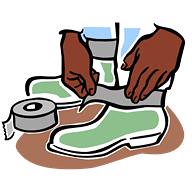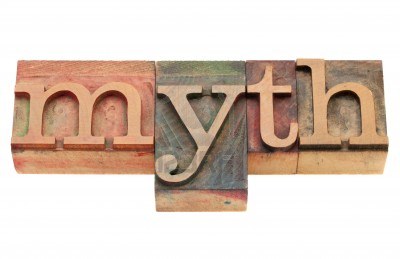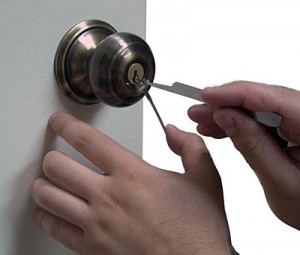This article was written by Gaye Levy of Backdoor Survival and originally posted here.
34 Ways to Use Duct Tape for Survival
I have always claimed – and not altogether jokingly – that you could build a house with Elmer’s glue and Duct Tape. Both items are readily available, relatively inexpensive and easy to tote around. I will set aside the Elmer’s for another time, though. Today, I thought it would be fun to look as some of the practical uses of duct tape around the house, camping and of course, in a survival situation.
First a bit of history
This miracle stuff was created during World War II when the US military needed a flexible, durable, waterproof tape to use making repairs in the field. A strong tape was created by Permacell, a division of Johnson and Johnson for this purpose. As the story goes, the GIs called it “duck tape” because it was waterproof – like a duck’s back.
Enough of the boring details. Just how can you use this miracle tape?
34 Uses of Duct Tape for Survival and Emergencies
Repair a tent: You open your tent at the campsite and oops — a little tear. No problem as long as you’ve brought your duct tape along. Cover the hole with a patch; for double protection mirror the patch inside the tent. You’ll keep insects and weather where they belong.
Make a rope: Twist one or several lengths of duct tape into a cord or rope. Of course paracord would be a lot better and you do have some of that, right?)
Make a clothesline: Twisting a long piece of Duct tape makes a great piece of rope to use as a clothesline.
Hold the feathers in your sleeping bag: If you have a hole in your down sleeping bag, you can patch the hole with duct tape. No more feathers flying out all over the place.
Reseal packages of food: Use duct tape to seal up partially opened packages of food. Fold over the top of the package and seal it tight with a piece of duct tape. Works for cans, too. Simply fashion a lid out of duct tape.
Hold your tent closed: A damaged zipper could leave your tent door flapping in the wind. Stick the door shut, and keep the bugs and critters out.
Splint a broken tent pole or fishing pole: Tape a stick to the broken area of your tent pole or fishing rod, and you might just get one last adventure out of it.
Catch pesky flies: Roll off a few foot-long strips of duct tape and hang them from a branch or your tent or cabin rafters. The DT serves as flypaper and when you depart, you can roll up the tape to toss it in the trash. No need to use nasty chemicals, either.
Repair your water bottle: Have a cracked water bottle or a pierced hydration bladder? A little strip of duct tape to the rescue. Be sure to dry the surface before you try to tape your patch in place since most forms of duct tape don’t stick to wet surfaces. You can also wrap plastic water bottles with duct tape to prevent cracking and leaking.
Make a spear: Strap your knife to a pole and you have a trusty spear to fend off beasts, or make one into your dinner.
Create a shelter: With some trash bags and some duct tape, and you have a survival shelter roof, or sleeping bag cover, a wind break, or well, there are kits of possibilities.
Wrap a sprained ankle: If you trip and sprain your ankle, wrap the ankle with duct tape to give it some support.
Make butterfly bandage strips: Cut two small strips of DT, and add a smaller strip across their centers (sticky side to sticky side) to create a makeshift butterfly suture.
Make a sling: Fold a length of DT down the middle, so that it is half the original width and no longer exposing a sticky side. Use the strap to make a sling for a busted arm.
Affix bandages: Place a sterile dressing over your wound, and strap it in place with DT.
Blister care: Cover the blistered area with a bit of cotton gauze, and tape over the cotton. Make sure that the duct tape fully covers the cotton and doesn’t touch the blister at all.
Create a splint: A broken ankle or leg can be stabilized with ample splint material, padding and duct tape. Pad the crotch of a forked branch with some cloth and duct tape to fashion a quick crutch to go with your splint.
Make a bandage: Fold tissue paper or paper towel to cover the wound and cover this with duct tape.
Make a temporary roof shingle: If you have lost a wooden roof shingle, make a temporary replacement by wrapping duct tape in strips across a piece of 1/4-inch (6-millimeter) plywood you’ve cut to size. Wedge the makeshift shingle in place to fill the space. It will close the gap and repel water until you can repair the roof.
Fix a hole in your siding: Has the stormy weather damaged your vinyl siding? A broken tree limb tossed by the storm, hailstones, or even an errant baseball can rip your siding. Patch tears in vinyl siding with duct tape. Choose tape in a color that matches your siding and apply it when the surface is dry. Smooth your repair by hand or with a rolling pin. The patch should last at least a season or two.
Tape a broken window: Before removing broken window glass, crisscross the broken pane with duct tape to hold it all together. This will ensure a shard does not fall out and cut you.
Mend a screen: Have the bugs found the tear in your window or door screen? Thwart their entrance until you make a permanent fix by covering the hole with duct tape.
Repair a trash can: Plastic trash cans that are blown over by a storm or frozen in an ice storm often split or crack along the sides. Repair the tear with duct tape. Just be sure tape over the crack both outside and inside the can.
Make a belt: Run a piece of DT through your belt loops and stick it to itself in the front. Overlap it about 4 or 5 inches and you’ll still be able to peel the belt apart when nature calls.
Repair your glasses: If your glasses break while you are out in the wilderness, tape them up. You might look a bit nerdy but at least you will be able to see.
Fix your rain gear: Keep the dry stuff dry, and keep the water out, by mending your ripped rain gear with a few strips of duct tape.
 Repair your clothing: Repair rips and tears in your clothing by slipping a piece of tape inside the rip, sticky side out, and carefully pressing both sides of the rip together. The repair will be barely detectable.
Repair your clothing: Repair rips and tears in your clothing by slipping a piece of tape inside the rip, sticky side out, and carefully pressing both sides of the rip together. The repair will be barely detectable.
Add extra insulation in your boots: Make your winter boots a little bit warmer by taping the insoles with duct tape, silver side up. The shiny tape will reflect the warmth of your feet back into your boots.
Hem your pants: No time to hem your new jeans? Fake it with a strip of duct tape. The new hem will last through a few washes too.
Make handcuffs: Create handcuffs for the bad guys by taping their hands together around a tree to prevent them from becoming a danger to themselves or others.
Mark a trail: Use duct tape to blaze a trail or signal for rescue, especially if your DT is brightly colored or reflective.
Make emergency repairs on your Bug Out Vehicle: Repair leaking hoses, broken tail lights, windows that don’t stay and even bullet holes with strips of duct tape.
Hang perimeter or security lights: String lights around your camp with a rope make of duct tape.
Make a disguise: Using trash bags and leaves, fashion a disguise then hold it all together with duct tape so that you can hide in plain sight.
The Final Word

Whose to say that it can’t go on for the next 70 years?
Enjoy your next adventure through common sense and thoughtful preparation!
Gaye













